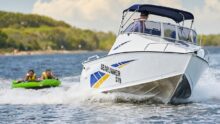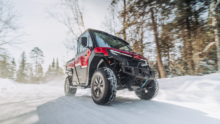YTD Adult ATV Sales Nearly Flat
U.S. adult-size ATV retail sales (i.e., 150cc & over) for the first five months of 2005 were running about 1% ahead of the same period a year ago, according to the 150 dealers we surveyed. Industry sales for the month of May were reportedly up about 5-6% over May 2004.
This increase through May is holding consistent with the declining low single-digit sales increases in adult-size ATVs over the last three years: 2.5% in 2004, 3% in 2003 and 4% in 2002.
And with the economic recovery shifting into a growth phase, forecasts of another low single-digit increase for the industry in 2005 appear to be reasonable. An overwhelming amount of sales continues to be bolstered by the generous finance and incentive programs offered by OEMs in recent years, which we’ll discuss later.
Several industry sources predict ATV sales will finish the year about 1% ahead of 2004 or basically flat, although most people don’t realize that this would in fact represent record sales for the sixth consecutive year in the U.S. ATV market. Moreover, these figures for the most part don’t include the growing number of Chinese imports 150cc and over that, by our calculations, would add another 2 percentage points to this 2005 forecast growth index. Sales of 500cc & over displacement machines are estimated to account for over a third of the current adult-size ATV market compared to about a fifth of all sales five years ago and zero ten years ago.
USED ATV SALES THROUGH DEALERS
According to our latest analysis from our dealer survey, used ATV sales through powersports dealerships averaged nearly 11% of new unit sales compared to 6.5% from our survey from a year ago.
This current figure, however, appears to be more consistent with the 15% ratio we recorded in late fall of calendar year 2003. Our only other readings of this ratio were taken in late fall of 2001 and 2000, at 13% each, so this most current ratio appears to be consistent with historical averages and not out of the ordinary.
DEALER INVENTORY LEVELS
Based upon the responses from all 150 ATV dealers we surveyed, dealer inventories on new ATVs at May month-end computed to about 3.0 months on hand compared to the figure of 2.2 months from last year’s April month-end figure.
This compares with 2.43 and 2.11 months on-hand from October and September of 2003 and 2.14 months on-hand from April 2003.
It is evident from our ongoing dealer surveys that ATV field inventories have been on the rise in the last year, and that at 3 months on-hand they are at the upper limit of the acceptable range of between two and three months.
OEMs certainly don’t want dealers carrying less than two months of new inventory on-hand but then they should also be concerned if this ratio significantly exceeds three months of field inventory on-hand.
With the proliferation of models in the ATV industry, it is increasingly important that dealers be able to accurately forecast their product mix of anticipated sales.
Used ATV inventories historically have averaged under one month on-hand. Our most recent survey, however, shows this index at about 1.35, which compares to 1.85 months of used ATVs on-hand from our reading of a year ago. Again, nothing out of the ordinary here.
ATV SALES BY PRIMARY APPLICATION
We asked the dealers we surveyed to provide estimates of their recent ATV sales based upon the primary application or use. Most ATVs, of course, are used in more than one application.
For example, farmers may use ATVs for farm chores, hunting or even recreational riding. Again, we emphasized the single most primary application. Here’s what we compiled, which we compared to our surveys from the last two years.
It appears that since our last reading from a year ago there has been a slight shift from older recreational riders to young sport riders and farmers, otherwise the data looks fairly consistent.
FIRST-TIME BUYERS
We asked our dealer body to estimate what percent of their new ATV sales through May are from first-time buyers. According to our weighted average based upon each dealer’s sales to date, the average was about 31%.
Our last two readings on this indicator were back in April of last year and November of 2002, which reflected 32% and 28% respectively. Historically this indicator was running at about 40% but in recent years indications are more owners may be trading in for larger displacement machines.
SIDE-BY-SIDE UTILITY VEHICLES
In our article from a year ago, we first mentioned the extent to which older ATV riders, 50 and up, are likely to start shifting from riding ATVs for primarily recreation to the newer “side-by-side” vehicles, which many simply refer to as utility vehicles. Besides being physically less demanding to ride off-road, the additional seating for other passengers along with a cargo bed for gear, game or a dog has shown considerable appeal.
Utility vehicles, which we profile annually each summer in the Trendline series, have become more popular with consumers in recent years, initially as a work vehicle but increasingly so in recreational applications. Large estate, hobby farm and horse farm owners have been buying them in large numbers. Hunters are also purchasing them in significant and growing numbers.
We asked our survey group of 150 dealers to estimate what percent of their potential ATV sales so far this year did they think were lost to side-by-side or utility vehicle purchases instead. According to the responses, the weighted figure averaged about 2%, indicating that at least for now dealers do not consider these vehicles to be a serious threat to ATV sales. This computes to roughly 16,000 lost ATV unit sales this year. Of the 150 dealer responses, 60 dealers said there were no noticeable lost sales compared to 90 dealers that stated some loss to varying amounts. This may quickly change over the next two years.
ATV PURCHASES, CASH VS. FINANCING
We asked the 150 dealers to estimate what percent of their new ATV sales were purchased with cash or credit card versus financing options and compared these to our 2001 estimates, prior to the generous OEM financing terms offered in more recent years.
It is very apparent that there has been a huge shift over to OEM financing programs since 2002 when these programs started becoming more prevalent in the industry.
Some industry sources have suggested that OEM financing may even be higher, at least 70% or more.
What is interesting is that those dealerships that have their own financing plans appear to have slightly increased their share while all the other finance options, including cash and credit card payments, have declined significantly.
OEM FINANCING IMPACT ON NEW ATV SALES
For a couple of years we have thought about asking dealers to estimate what percent of their ATV sales they believe “have resulted directly from these aggressive OEM finance programs.”
According to the responses from all 150 dealers we asked, based upon their respective sales to date, the weighted average was 47%.
Estimates ranged from as low as 0% and 5% (5 dealers) all the way up to 90% and over (9 dealers). Although this figure seems rather high, it nevertheless proves the effectiveness of these programs during periods of sluggish ATV and other powersports machine sales. Only when sales approach double digit growth rates again can we expect to see a curtailment in the terms and programs offered by the OEMs.
Dave Crocker is senior partner for Power Products Marketing, a market research firm based in Minneapolis, Minn. PPM (www.powerprods.com) specializes in the power products and components, powersports and marine industries. Crocker may be reached at 952/893-6870 or at dcrocker@powerprods.com.







